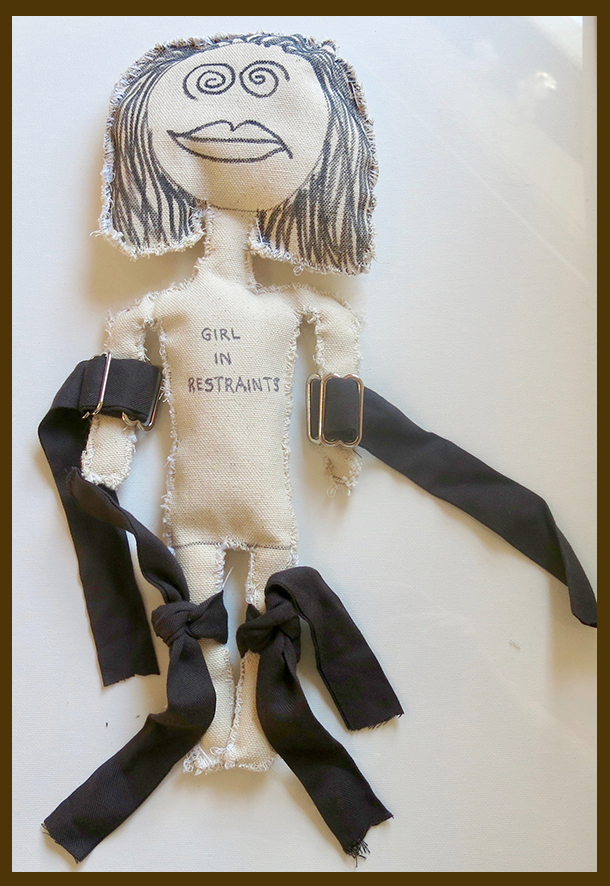
A SELF-TAUGHT ARTIST FINDS HEALING VALUE IN THE MAKING OF A SPECIAL KIND OF SCULPTURAL, MIXED-MEDIA ART
by Edward M. Gómez
It has been said, wisely, that fear eats the soul. Anger, too, is a potent, toxic force.
But what about the effects and impact on the human spirit of broader, enduring trauma, of which fear and anger — a person’s sense of rage in reaction to whatever violation he or she has suffered — are essential, often inescapable parts?
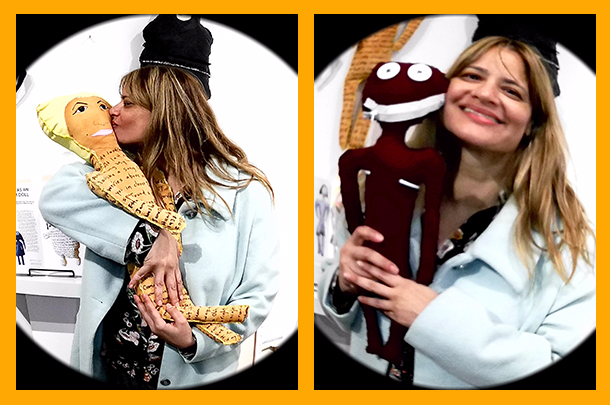
The artist Susan Spangenberg (Instagram: @straitjacketsusan) is someone who has spent much of her life on a healing path in response to early-childhood traumatic experiences. Today, she is a strong, self-aware, capable, and unsinkably creative woman, someone who has transformed pain into the visual poetry of works of art in various media and genres.
She is still aware, however, of her vulnerabilities and of a need to be cautious and to protect herself in a world that can be harsh and in which, sadly, kindness and goodwill do not flow in abundance.
In early March, Spangenberg’s charming and cleverly constructed “Asylum Dolls” were featured at the 2024 Outsider Art Fair in New York in the booth of Fountain House Gallery, a New York City-based organization with which she has been associated for several years. Fountain House runs an art-studio program and a related gallery. Its mission is rooted in the so-called clubhouse model for people living with serious mental illness. (Read about Fountain House’s history here.)
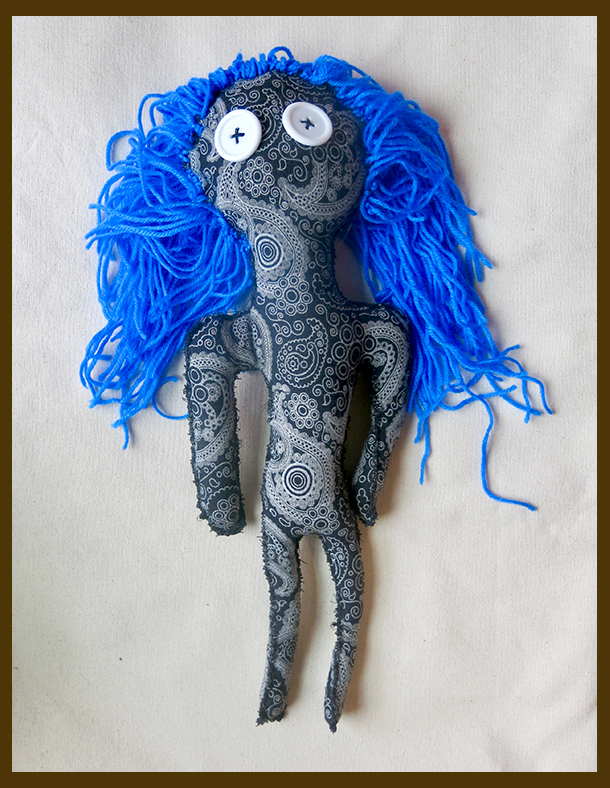
Sensitive and inquisitive, too, Spangenberg is deeply committed to making art and also very interested in learning about other artists’ creations and their motivations for producing their own works. In many ways, she is her own best spokesperson, for no one understands the impulse that prompts her to make her art better or more insightfully than the artist herself.
With this in mind, here are some excerpts from an interview brutjournal conducted with Spangenberg on the occasion of the recent Outsider Art Fair in New York.
brutjournal: Tell us about your upbringing and background. When you were a child, were you interested in and did you make art?
Susan Spangenberg: I was born in the Hell’s Kitchen area of Manhattan, in New York City, but I grew up in Jackson Heights, Queens, a block away from Saint Joan of Arc Roman Catholic Church, which has always played a role in my life. At home, we didn’t follow any religion. My mother, who was of Trinidadian-Indian descent, was Hindu and also dabbled in voodoo. My father was German-American of Lutheran/Christian descent.

We celebrated a few American holidays, such as Christmas and Easter, for presents and the Easter Bunny. Our neighbor, Mary, gave my twin brother Rob and me a religious children’s book. Rob, who fell in love with reading, would read the stories out loud to me. I’d sit and visualize my own images and the people in the stories, in which I played [various characters’] roles in my mind.
The first images of art I remember seeing were in a church, in stained-glass windows, and then in a children’s book of the Bible. We didn’t grow up with art and were otherwise not exposed to it.
brutjournal: As a child, did you make art – paintings, drawings, objects – or when did you start making art?
Susan Spangenberg: My first memories in general and my first memories of making art [date back to] when I was three years old. I remember climbing up in the kitchen and my mother hitting me over the head with a frying pan. I fell unconscious and had to get stitches. I still have a scar. I was not allowed to make art at home. In school, kids made fun of me and called me “Frankenstein” because of my scar. My mother wouldn’t let me paint in the house.
My mother only let me sew and mend the hand-me-down clothes the church donated to us. She said making art was “idle.” Although I longed to sew and make art as a child, I was punished [if I did so], or she destroyed my art as a punishment for creating. I literally didn’t talk for most of my life. I pulled my hair out and stared into space. I made my first painting when I was three years old. My father got me a cheap watercolor set, because I didn’t talk.
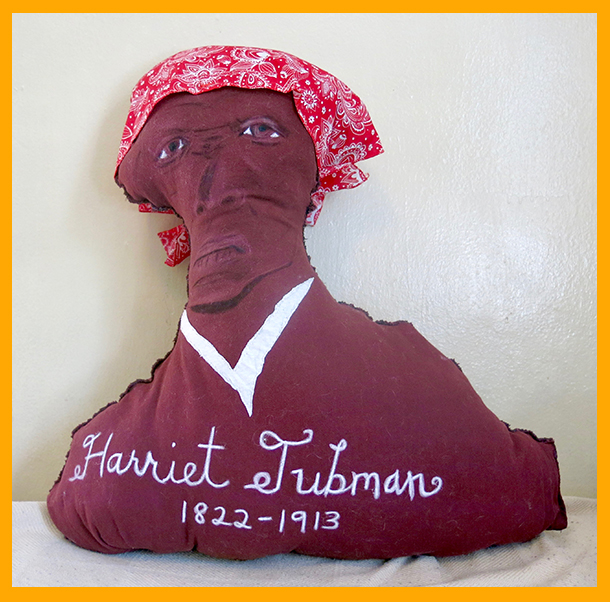
brutjournal: When did your association with Fountain House begin?
Susan Spangenberg: I joined Fountain House Gallery in 2015 and, since then, I’ve taken part in every exhibition there except for two. We present six shows a year, and sometimes an auction as well.
brutjournal: When and why did you start creating your dolls that represent various well-known people, including artists and historical figures?
Susan Spangenberg: When I do write, I feel my brother is writing, not me. I feel he helps me with my stream-of-conscience writing in my art and sometimes guides me in my research [when I look for letters written by the historical figures who are the subjects of my dolls].
I have a letter of his, the only piece of his writing that I found after he died, which was addressed to my mother from rehab. In the case of my “Asylum Dolls” that are icons, my twin [Rob], as well as God and the deceased people I reincarnate, ask me to tell their stories. They tell me what to write and where to look for their words, giving me their blessing [to do so].
I’ve had many visions, hallucinations, dreams, and other signs that have prompted me to make my icon dolls. Visions of such subjects as the nuclear scientist J. Robert Oppenheimer and the historical figure and Roman Catholic saint, Joan of Arc, have come to me. I’ve chosen other subjects, such as the American movie actress Frances Farmer [1913-1970] and the Japanese modern artist Yayoi Kusama, both of whom, I learned, like me, had spent time in psychiatric hospitals.
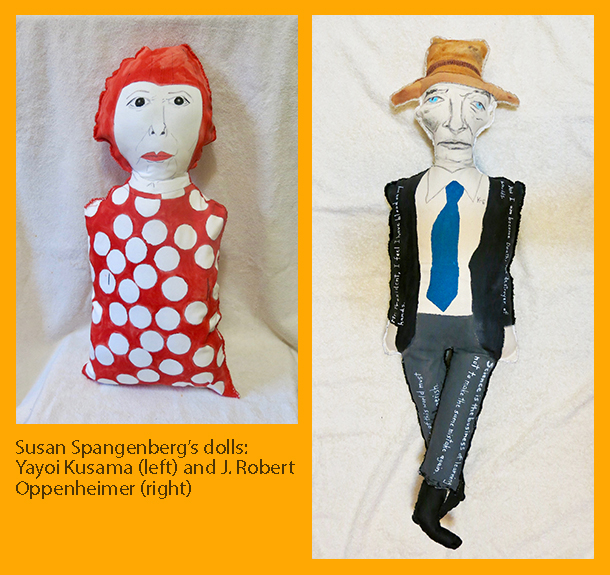
brutjournal: It seems that mental illness or the experience of some kind of psychic hardship or obstacle is a common theme when looking at the life stories of the historical figures and artists who are the subjects of your “Asylum Dolls.”
Susan Spangenberg: Some were in asylums like myself. To make some of my dolls, I’ve repurposed some of the patient’s gowns I wore myself during my many stays in psychiatric hospitals. I refer to my “Asylum Dolls” that are not icons as “Average Gals.” They’re people like me who are not famous; some are reminiscent of the people I met during my stays in psychiatric hospitals.
For example, my doll called “Long Tall Sally” was a young, African-American girl who used to lie in my lap. I was in my twenties, and she was a teenager, maybe thirteen years old, but tall with dreads. The staff would make her get up, only for her to come back and lie on top of me for comfort, like a cat.

Other dolls have emerged from my imagination and are versions of myself. The first “Average Gal” doll I made, “Girl in Restraints” represents myself. It’s a self-portrait. I spent my teenage years and twenties in restraints. My “Healing Dolls” depict historical figures who might not have been diagnosed with mental illness but they are icons like [the abolitionist and social activist] Harriet Tubman [1822-1913], whom I consider to be the greatest American I can think of; during the era of slavery, she helped others escape after escaping herself.
brutjournal: Tell us a bit more about what you see as the therapeutic value or character and the meanings of your dolls. What do they mean to you and what would you like viewers to notice or feel when they encounter these unique creations? Also, what materials do you use to make your dolls?
Susan Spangenberg: Therapeutically, the dolls have become my friends. Like Frankenstein, I don’t have any friends. I feel very alone. I isolate myself. I push people away because it’s hard for me to trust people. I don’t feel safe in the world. I feel close to God, nature, animals, trees, and a few select people, like my therapist and my Shakespeare teacher, Peter Francis James, or “PFJ,” as he asks us to call him in class, who take care of me. [Spangenberg’s stage name, which she uses when performing as an actor, is “Shyla Idris.”]
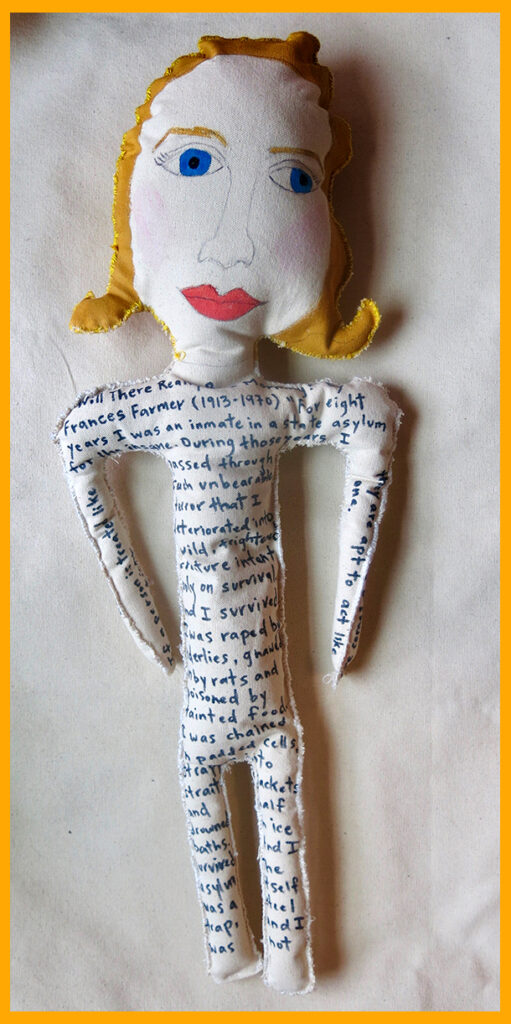
I feel that my dolls are alive. If you listen, they’ll speak to you. They’re meant to heal and comfort. They are spiritual beings and emanate love and good energy. Sewing my dolls celebrates lives lived as well as my own survival in my own life. I’ve survived [the pain of] a mother who didn’t love or want me. Every stitch I sew helps mend that wound.
[To make my dolls,] I have used found materials. I buy unstretched canvas and scraps of fabric for 50 cents or a dollar at the fabric store. I buy thread and buttons from the 99-cent stores and I buy stuffing online.
brutjournal: Are there any other artists’ works that have inspired or influenced you?
Susan Spangenberg: No. However, I was influenced by actors. I watched films with my father, and he introduced me to acting. I wanted to be an actor since I was 13 years old, specifically, a Shakespearean actor.
Growing up, my favorite actor was Rod Steiger. My favorite play was and is still “Hamlet.” I’ve been drawing and painting since I was three years old but I never studied art or saw myself becoming an artist or thinking of myself as one.
I certainly never knew there was such a thing as a gallery, with white walls, and that my art would ever be displayed on them. But lucking into Fountain House Gallery did that for me. As a child and teenager, I slept on the streets of New York City with my alcoholic father in Hell’s Kitchen. The gallery wasn’t there back then.
It feels great to be part of Fountain House Gallery in Hell’s Kitchen — to come home to Hell’s Kitchen, where I was born.
